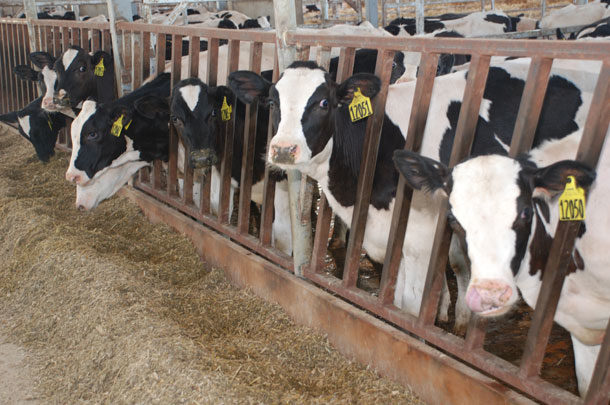An investment in your calf nutrition program is an investment in the future of your herd. Research has shown that a calf diet focused on good, healthy growth from birth to breeding can reap significant increases in first-lactation milk yield.
Like many areas on the dairy, having a methodical approach to your calf nutrition program can help it run smoother. Setting clear growth targets and tracking progress are keys to a successful calf nutrition program.
Ensuring everyone on the calf team is aware of the growth targets, how to achieve them and why they are imperative to long-term profitability will make sticking to the program easier.
Target 1: Double their weight
Young calves should double their birth weight by 50 to 60 days of age. To help achieve this goal:
- Feed 4 quarts of colostrum within an hour or two of birth.
- Feed a high volume of milk or milk replacer – at least 2.5 pounds of milk solids per calf per day.
- Offer calf starter (20 to 22 percent protein) one to three days after birth to initiate rumen development. This is critical as calves are born with a nonfunctioning rumen, and calf starter drives rumen development. The fermentation from water and feed are needed to properly develop a calf’s rumen. Delaying calf starter intake can delay rumen development, ultimately delaying the age at which calves can be weaned.
- Offer fresh, clean water.
Target 2: Focus on average daily gain
Studies have shown that a 1-pound increase in average daily gain (ADG) before weaning resulted in a 1,551-pound increase in first-lactation milk yield. Set a target ADG of 2.2 pounds from 61 to 120 days of age, and 2 pounds from 121 to 180 days of age. A diet with a higher plane of nutrition can help meet ADG goals, while helping develop a fully functioning rumen.
Target 3: Maintain growth after weaning
Often times, calf raisers may notice a growth slump in weaned animals. Since their bodies can’t digest and absorb adequate nutrients and energy from forage alone, growth rates may suffer if forages are introduced too quickly.
Calves aren’t ready for high forage diets until they are 5 to 6 months old because the rumen continues to develop during this time. Once weaned, calves should be offered complete feeds as the majority of their diet. To help calves transition to a diet higher in forage and maintain their nutritional needs, introduce a calf grower feed.
It’s crucial to continue to focus on nutrition for this group and monitor growth. As heifers approach puberty, key nutrient demands increase to prepare for reproduction.
Target 4: Enter milking herd
Target weights and hip heights for breeding heifers are based on mature cow measurements in your herd. If your average mature cow weight is 1,550 pounds, then the target breeding weight for heifers is about 850 pounds (55 percent of mature cow weight), with a hip height greater than 50 inches and wither height greater than 48 inches.
Keep in mind that there is added financial potential if calves reach breeding size sooner, as age at first calving can be reduced. Industry data suggests that each month calving is delayed beyond the 22-month target costs dairy producers approximately $100 per animal.
Post-calving weight would be about 1,325 pounds (85 percent of mature cow weight). Aim for a body condition score at freshening of 3.5. A proper nutrition program is essential, as fat and thin heifers can result in costly conditions.
Fat heifers often experience lower dry matter intakes pre-calving and post-calving, and increased incidence of energy-related disorders such as ketosis and displaced abomasum. Thin heifers often underperform because they extend the period of time they are in a negative energy balance, and their calves typically are less vigorous and can have a reduced ability to absorb immunoglobulins.
Measure progress
Without measuring calf growth from birth to weaning, post-weaning to breeding age and then from breeding age to calving, dairy producers cannot effectively measure the return on their calf and heifer nutrition investment.
To effectively monitor growth rates, plan on evaluating calf and heifer growth regularly. An efficient time to measure individual animals is while they are locked up during feeding or routine health checks. Weight tape and hip sticks are effective tools to capture growth performance.
Consistently measuring calf performance will give you the opportunity to identify calves that aren’t meeting growth goals, address the cause and make adjustments as needed. Identifying problems early is vital to helping each calf reach her full potential.
Also tracking other key indicators such as treatment and mortality costs of calves, heifer pregnancy rates and first-lactation milk yield can help you determine the effectiveness of your calf nutrition program. When looking at the big picture, the cheapest calf ration can end up costing more in the long run.
The time and attention put into a calf nutrition program will ultimately result in healthier, more productive cows that produce stronger offspring – a return on investment that can be calculated for generations to come. PD
References omitted but are available upon request. Click here to email an editor.

Gary Geisler
Calf and Heifer Specialist
Purina Animal Nutrition
PHOTO
Photo provided by Purina Animal Nutrition.





